Crochet Hooks: Varieties and Tips
Greetings, everyone! Today, we’re delving into the world of crochet hooks. If, like me, you’ve ever wondered which needle is best for bringing your crochet creations to life, you’re in for a treat with this article.
In a previous piece, I talked about crochet threads and how the ideal needles for each project are typically specified on the thread labels. However, the universe of crochet hooks is vast, with different types and manufacturers available, just like with threads. Moreover, these needles come in various materials, as we’ll explore throughout this article.
So, it’s crucial to acquaint yourself with the different types of crochet hooks to make informed buying decisions. Choosing the right crochet hook is essential for comfortable crocheting and ensuring your projects turn out beautifully. In this article, we’ll explore various types of crochet hooks and provide valuable tips for beginners to set you on the right path in your crochet journey.
Anatomy of a Crochet Hook

- Head: the point of the hook
- Throat: the inner section of the hook
- Shaft
- Grip
- Handle
Which Crochet Hook is right for you?
When it comes to crochet hooks, there are primarily two types: inline hooks and tapered hooks. Many crocheters have their own preference, and your decision often boils down to what you initially used when learning to crochet.
Inline Hooks: These hooks feature pointy heads that match the shaft’s size, and the shaft is relatively short. Some crocheters favor inline hooks because they believe they help create uniform stitches and maintain consistent tension.
Tapered Hooks: Tapered hooks come with rounded heads, a narrower throat compared to the shaft, and a longer shaft. Some crocheters find tapered hooks more convenient as they make it easier to insert the hook into stitches, and the additional length provides greater flexibility while crocheting.
In the end, the choice is all about your personal preference. We recommend experimenting with both types of crochet hooks to determine which one suits you best.

HOLD YOUR CROCHET HOOK
To hold your crochet hook, you have a couple of options, and it really depends on what feels comfortable for you and the type of crochet project you’re doing. Most people use one of these two main grips:
- The Pencil Grip: Hold your hook like you would hold a pencil, with a three-fingered pinch. (shown in the top image)
- The Knife Grip: Hold your hook like you would hold a steak knife, with your last three fingers controlling the hook’s movement. (shown in the bottom image)
There are actually more ways to hold a crochet hook, but these are the main ones. As you become more experienced with crocheting, you might discover that some grips work better for specific types of crochet projects. The important thing to remember is that there’s no one “right” way to hold a crochet hook—just go with what feels best for you!
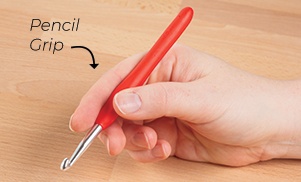
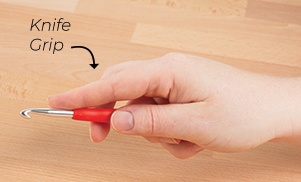
Types of Crochet Hooks
As mentioned earlier, the recommended hook size for each type of crochet yarn can be found on the yarn label. Sometimes, a project might call for multiple hook sizes to achieve the desired effect. However, crochet hooks have additional characteristics beyond their dimensions that aren’t typically detailed on yarn labels. Understanding these details is crucial.
Crochet Hooks Dimensions
Crochet hooks are standardized in millimeters, a measure adopted by all manufacturers. Although some manufacturers may use their own custom numbering, the most relevant information is the measurement in millimeters engraved on each crochet hook. Keep this in mind.

Now, let’s explore the various materials used to craft crochet hooks.
Materials Used in Crafting Crochet Hooks:
Crochet hooks come in a wide range of materials, and they can even be found in different colors. Some examples of these materials include:
- Metals: (Aluminum, Steel)
- Rubber
- Plastic
- Bamboo
Let’s begin our discussion with metal needles:
Colored Aluminum Needles
First, we have vibrant aluminum crochet hooks available in a range of sizes, from 2mm to 10mm. Each needle size is associated with a specific color, making identification easier. These colored aluminum needles are not only lightweight but also facilitate efficient and agile crochet work.
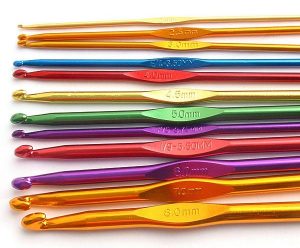
Nickel-Plated Steel Needles
Nickel-plated steel needles are some of the most recognized and frequently used crochet hooks, especially for delicate thread projects. They come in sizes ranging from 0.6mm to 2.1mm, covering a range of sizes.

Aluminum Needle with Plastic Handle
These hooks are popular among crochet enthusiasts and come at a slightly higher cost due to their ergonomic design, offering superior comfort during extended crochet sessions.
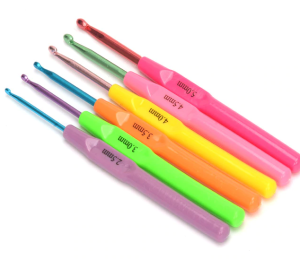
Steel Double-Point Needles
These steel needles have two ends with different sizes and are available in a range from 2.0mm to 5.0mm. They are commonly used for Tunisian or Afghan crochet practice.

Aluminum Needle with Bamboo Handle
For bamboo needle enthusiasts looking for a smoother thread glide, these needles are an excellent choice. They are particularly well-suited for Baroque-type yarn projects, offering both functionality and style.
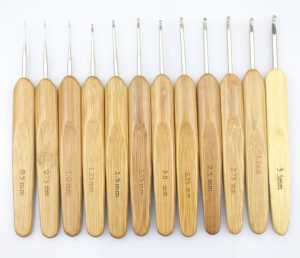
Whether you’re just starting out in the world of crochet or have been at it for a little while, having an easy-to-understand conversion chart for crochet hooks can save you a lot of time and confusion. One of the common dilemmas we face is figuring out which crochet hook size is best for our projects.
What size crochet hooks to use?
Not sure which crochet hook to use as a beginner? It’s actually quite simple! Just look at the label on your yarn. Yarn labels typically tell you:
- Yarn weight, ranging from 0 (LACE) to 7 (JUMBO).
- The recommended crochet hook size and knitting needle size.
- Gauge info, which lets you know how many stitches and rows to make in single crochet to create a 10″ x 10″ square.
By following these yarn label details, you’ll be able to confidently choose the right crochet hook for your project.
How important is it to follow the crochet hook size mentioned on the yarn label?
Yarn labels offer helpful recommendations, but in some cases, using a slightly smaller needle may produce better results.
On the other hand, when working with JUMBO yarn, you can opt for a larger crochet hook to achieve a soft, voluminous appearance in your piece.
Why should you consider a crochet hook size conversion chart?
Nowadays, learning knitting and crochet online has made it much more accessible, regardless of your location in the world. However, many crochet enthusiasts find hook and hook sizes confusing because different countries have different sizing systems.
To help you select the appropriate crochet hook size for your project, we offer charts that simplify the world of crochet hook sizes and make it easier to use.
Easy Conversion Chart for Crochet Hooks
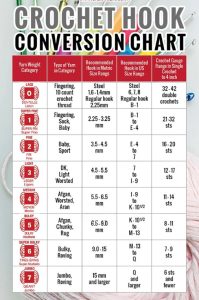
Many crochet patterns are made for thinner and medium-weight yarns. So, it’s a good idea to have G6 (4mm) and H8 (5mm) crochet hooks because they’re commonly used. The size of crochet hooks in the US can be a bit confusing, as they can be represented by letters or numbers. What’s the trick? Try to think in millimeters when it comes to crochet hook sizes!
If the pattern you’re working on is in UK terms and uses millimeters, you can convert the size to US terms to see if you already have the right crochet hook in your set.

GUIDE TO CROCHET HOOKS VIDEO
We’ve put together a video here from the Naztazia Channel that explains the difference between crochet needles and gives you excellent tips, be sure to watch it!
In Conclusion
In the end, finding the most suitable crochet hook or thread for your preferences or projects is a matter of consistent practice in the world of crochet. Your own experiences in the craft will be your most reliable guide. If you happen to come across a crochet hook design that’s not covered in this article, don’t hesitate to share your discovery with us here. Happy crocheting!

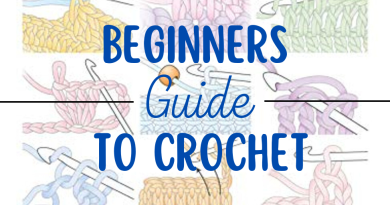

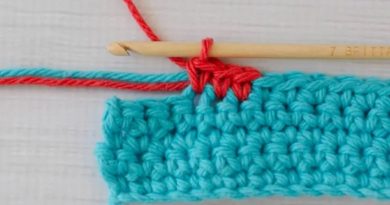
Gracias por sus consejos, un saludo desde México
Soy principiante aunque he hecho mis piesas, a mi me han gustado pero tejo lo básico, me interesa aprender puntos más delicados y con giros. Otros en que el tejido quede más a relieve. Me gusta hacer tapetes, sobrecamas. Quisiera aprender hacer zapatos, gorros y mochilas y/o carteras
Yo quieroo son bellisimo cual es el precio
Hola estoy empezando con el tejido, me encanta y me desestresa muchísimo, me gustaría aprender más para un futuro negocio con la ayuda de Dios 🙏